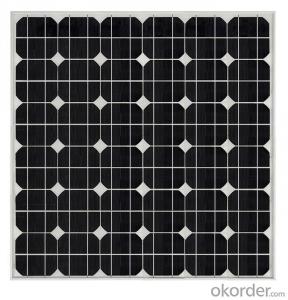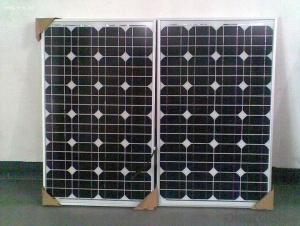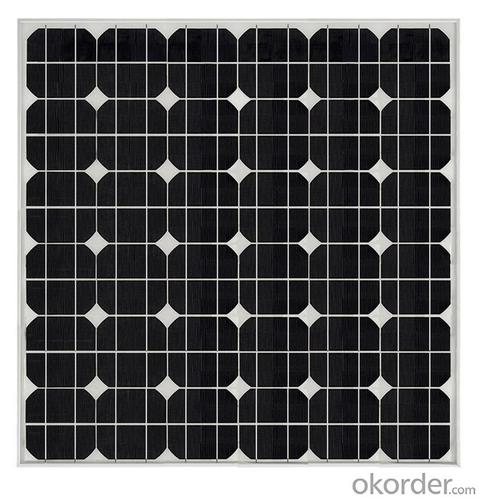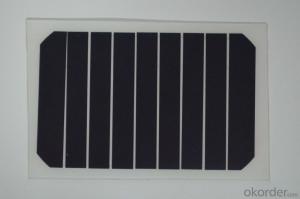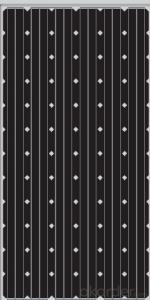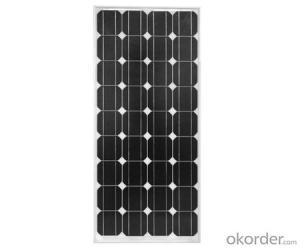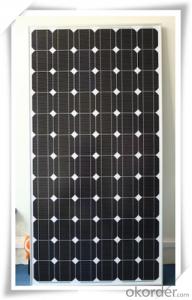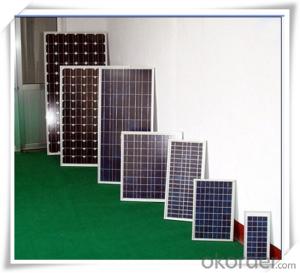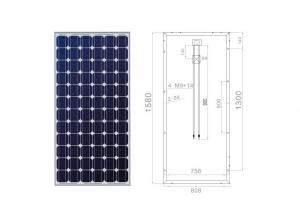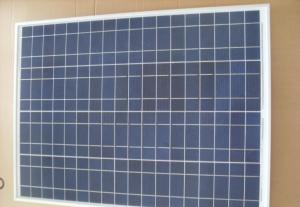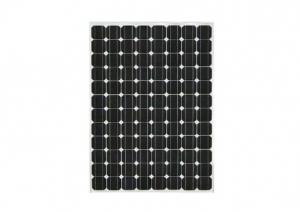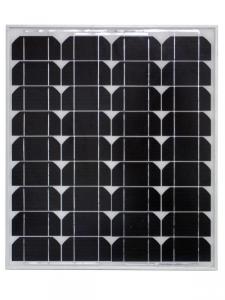OEM Mono Sun Power Solar Panels Rental from 5W to 300W CNBM
- Loading Port:
- Qingdao
- Payment Terms:
- TT OR LC
- Min Order Qty:
- 10 set
- Supply Capability:
- 300000 set/month
OKorder Service Pledge
OKorder Financial Service
You Might Also Like
OEM Mono sun power solar panels from 5W to 300W--- Factory direct sale
Quick Details
| Place of Origin: | Guangdong, China (Mainland) | Brand Name: | CNBM | Model Number: | SGM-2F-160W |
| Material: | Monocrystalline Silicon | Size: | 505*1005*70mm | Number of Cells: | 36pcs |
| Max. Power: | 160Wp | Modes of Supply: | Factory Directly Supply | OEM panel solar: | Acceptable |
| Cell Brand: | Taiwan solar cells | Cell efficiency: | 15.94%-18.10% | Frame: | Aluminium Alloy |
| Certificates: | TUV, IEC, CE, ISO9001/14001 and RoHS |
Packaging & Delivery
| Packaging Details: | carton box & wooden pallet [ solar panels ] |
| Delivery Detail: | 10-15working days after order confirmed |
Product Description
1.with controler, cable, mounting and bag, ready to use
2.High transmittance low iron tempered glass with enhanced stiffness and impact resistance
3.Unique frame design with high mechanical strength for easy Installation.
4.Advanced encapsulation material with multiplayer sheet lamination to provide efficient protection from the severest environmental conditions
5.Outstanding electrical performance under high temperature and low irradiance conditons
6.it can be widely used for home, for camping, for emergency
Electrical Character
| Electrical Characteristics | |
| Model | SGM-2F-2x80W |
| Cells size (mm): | 156*78 |
| Cells per module: | 36pcs |
| Module size (mm): | 505*1005*70mm |
| Power tolerance: | +/-3% |
| Nominal peak power(WP): | 160w |
| Nominal voltage(V): | 17.7 |
| Nominal current (A): | 9.03 |
| NOCT: | 45+/-2degree |
| Voltage temperature coefficient: | -0.33%/degree |
| Current temperature coefficient: | +0.05%/degree |
| Power temperature coefficient: | -0.23%/degree |
| Open circuit voltage (Voc): | 21.6 |
| Short cirsuit current(Isc): | 9.76 |
| Conversion efficiency: | 18.40% |
| Product name : | protable solar panel |
| Max system voltage: | 1000V DC |
| Surface Maximum Load Capacity | 60m/s(200kg/sq. m) |
We can offer:
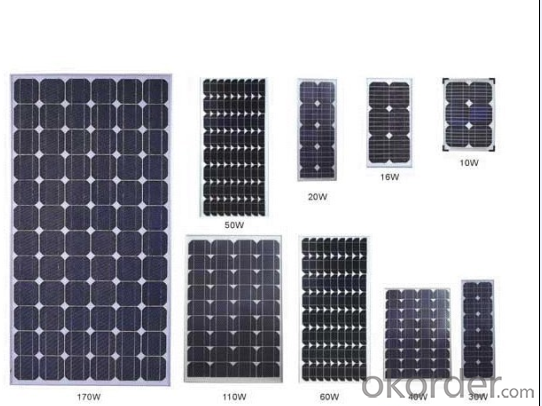
- Q: I am curious about how much of the energy that a solar panel of a given size and capacity will produce in it's lifetime, and what fraction of that energy was required to produce it in the first place?
- The attached link is to an article from the 200 Home Power magazine. In that article the energy payback was found to be between 2 and 4 years. Newer panels are more efficient primarily because the silicon wafers used today are thinner. The silicon cell embodies most of the energy required to make a solar panel. Today most solar panels will produce the amount of energy required to manufacture them in between about 9 months and 2 years depending upon the specific technology used to make it. Solar panels are expected to produce energy for between 30 and 50 years. Therefore it takes around 5% of their total energy production to produce them. Note that these figures depend upon where the panels are installed. Panels in very sunny areas may generate more than 3 times the energy of panels in a cloudier area. Edit - The energy payback meta-study that carbonates references below mention one particular study Alsema (2000), which the authors used as a baseline to come up with their 4 year payback figure. These studies DO NOT assume ideal conditions. The Alsema study assumes an annual an irradiation of 700 kWh/m2/yr. That is the United States average irradiation and does take into account cloudy weather and the like. Under idea conditions the amount of energy collected can be almost twice as much. Albuquerque New Mexico is an example. The figures I mentioned above are recent values reported by several different panel manufacturers with whom I discussed the issue at the 2006 IEEE 4th World Conference on Photovoltaic Energy Conversion held this May. The very long payback times that carbonate highlights are almost certainly wrong. The study he references concludes that paybacks range between 2 and 8 years with 4 years being the most likely. In my opinion payback times are actually a fair bit shorter based on conversations with the manufacturers.
- Q: Can solar panels be used in areas with high levels of wildlife activity?
- Yes, solar panels can be used in areas with high levels of wildlife activity. While it is important to consider the impact on local wildlife, there are measures that can be taken to mitigate any potential negative effects. Proper installation, such as elevation and orientation, can reduce the likelihood of wildlife interference. Additionally, using appropriate barriers or deterrents can help protect the solar panels and prevent damage from animals. Overall, with proper planning and precautions, solar panels can be successfully utilized in areas with high levels of wildlife activity.
- Q: Can solar panels be used in areas with high levels of sand or dust deposition?
- Yes, solar panels can be used in areas with high levels of sand or dust deposition. However, regular cleaning and maintenance of the panels may be required to ensure optimal performance.
- Q: K i'm almost ready to give up! I've bought every kind of pv I can think of, and I can see this technology will not be affordable in my lifetime.I conserve all I can (so far as to handwashing my laundry etc) I'm not rich, but I'm saving for a solar pv with decent amperage. I love tinkering with things if I see the point.All the cells i've seen are very weak. What PV would you buy? (all I need is to power my computer from a deep cycle 2 volt battery connected to an inverter)God Bless You
- Try now. It's much cheaper
- Q: the solar panel works with LEDs, small bulbs,etc but neve with any dcmotor. Please help. I have a science exhibition.
- Because its not voltage related its current related. look at the start up values for the motor w respect to current. This will be listed in amps or milliamps. Then cross reference that to the output of your solar panel also listed in amps or milli amps... ;)
- Q: If you were to be asked to write a material(s) report on either -solar panelsor -aircraft fuselageWhich would you choose?well i was asked to choose between these two,so i guess that if i choose what the majority wouldn't, i might just score a little bit higher,what do you think?if you are the lecturer you would want something different right?
- Solar Panels. Solar panels is a generic term for any semiconductor that converts solar energy to electrical energy. However there many different kinds of solar panels and constructed in different ways from different materials. There is the generic polysilicon solar panels for residential installation on one end of the spectrum. On the other end are very high efficiency (and expensive) solar cells used on the Mars Orbiter that are constructed of so called triple junction GaAs/Ge solar cells. In addition there are also the thin film solar cells that are being researched that use Cadmium Telluride (CdTe) to form junctions and make very efficient cells on very thin substrates. I would say that research into materials that can be used for solar cells is one of the hottest research fields right now. (That being said, I really did enjoy Airframe by Micheal Crithon. Whenever I'm in a plane during bad weather I always thing of the engineers that designed the plane... what assumptions did they make... what tradeoffs did they make... )
- Q: i have 2 questions.. I have a 6v solar panel, if i wanted to charge batteries with that it what batteries could i charge? Could charge normal AA batteries with it our do i need special batteries.2. I have a 6v solar panel that produces watt. I want to light a bulb with it but whenever i hook it up the solar panel won't light it up. I think the current of the solar panel is too low. How can i increase the current of the solar panel
- [] Use it to charge 4 pieces AA cell ( connect in series to make 5V battery pack ) for 0 to 4 hours. Good for cell rated 600mAH ,2000mAH,2500mAH. [2] Cannot increase current. Buy some more this panel and hook them together in parallel to increase current. You need at least ten pieces to make current reaches .6A to light up some 6V bulbs.
- Q: When people buy small solar panels, what are the steps to making it actually charge or run something.. I'm completely new to this of course and im curious. what kinda of wire and other devices are needed and how do you attach the wire and everything..
- It is quite complex from an engineering point of view. If the objective is academic, then it is worth the education for a small system. If it is to save money, whether it is viable depends what are the current rates where U are and a whole bunch of issues. The current technologies available are very far from one size fits all! Hope this answers your question
- Q: i would like to hook up a power outlet to a solar panelmy light system is 500watts will run for 8 hours/day between noon to 8PM.So what is the most effective system do I need?
- You will need at least 500 W of solar panels (probably more to cope with cloudy days), and a DC to AC inverter. Since you're going to 8pm you *may* want a battery bank system too for those shorter winter days.
- Q: I wanna get a solar panel to charge or 2 car batteries. Then connect the battery to a 800watt power inverter so that I can power a tv. Will the 8watt solar panel charge my batteries and around in how long?I just wanna use the panel to charge the batteries, no to use the panel directly with my electronics. Thanks for your answer and help me with that.
- 8w will be .5 amps or so.That would charge a .5 amp battery in an hour.scale that up to whatever your battery amp-age is and you will have an idea.But given that car power is upwards of 40 amp/hour,your looking at 60 hours+ for a full charge on small battery.I run a 400w inverter for emergency lights and tv (get the occasional power cuts)from an old truck battery with big amps and charge it with an optimate,but in doing so I found that I had to run a amp check on power draw to find the lowest use lights.and tv,Some of the so called low power consumption compact fluorecents had widely variable draws,after testing one was found that drew .68 amp and I chose the lowest mesured tv amperage draw.not exactly an answer to your qu,but end use is the same.Running the lamp only I eventually gave up checking on the drain after about 30 hours and now just periodicaly charge the battery.Rounding off.tv draw maybe 3 amps for a small set and watched for say 6 hours would be 8 amps drawn.that would need -2 hours on your proposed set up in ideal conditions.I have kept the figures rough because there is always losses in any system .so it comes down to how much tv you watch and how much the sun shines
Send your message to us
OEM Mono Sun Power Solar Panels Rental from 5W to 300W CNBM
- Loading Port:
- Qingdao
- Payment Terms:
- TT OR LC
- Min Order Qty:
- 10 set
- Supply Capability:
- 300000 set/month
OKorder Service Pledge
OKorder Financial Service
Similar products
Hot products
Hot Searches
Related keywords
